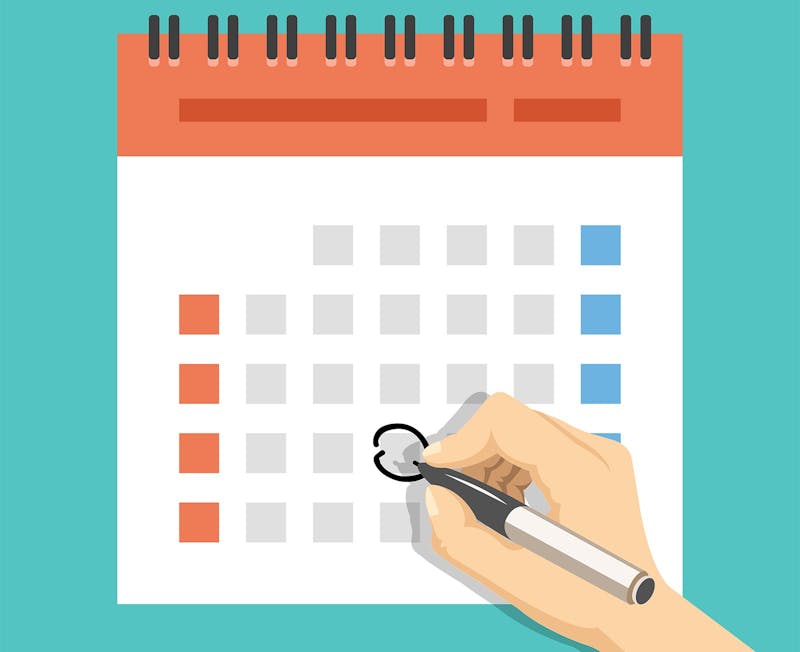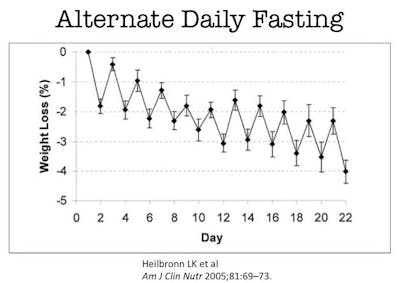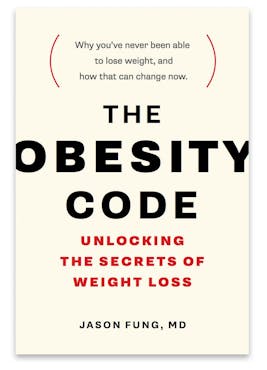36 Hour Fast Diet Plan

- 24 hours
- 5:2
- Alternate day
- Risks with longer fasts
- 36 hours
- 42 hours and beyond
This post is about longer fasting periods – 24 hours or more – and how to do them.
I arbitrarily divide it at 24 hours but there is no physiologic reason to do so, other than for classification purposes. There is no magic dividing line ad many consider 36 hours the cut-off for longer-term fasts.
We covered fasting regimens using periods less than 24 hours previously. The longer regimens are generally done less frequently. The major determinant of which fasting regimen is right for you is a personal preference. Some people find longer fasts easier and some find them harder.
Most people find that hunger increases into day 2. At that point, hunger peaks and then gradually recedes. This is important knowledge if you are attempting a longer fast (3-7 days). It is easier to continue knowing that hunger usually gets better.
Disclaimer: While intermittent fasting has many proven benefits, it's still controversial. A potential danger regards medications, especially for diabetes, where doses often need to be adapted. Discuss any changes in medication and relevant lifestyle changes with your doctor. Full disclaimer
This guide is written for adults with health issues, including obesity, that could benefit from intermittent fasting. Learn more.
People who should NOT fast include those who are underweight or have eating disorders like anorexia , women who are pregnant or breastfeeding , and people under the age of 18 . Learn more.
Around one day long fasting periods
24-hour fasts
A 24-hour fast lasts from dinner to dinner, or breakfast to breakfast, whatever you like. For example, you would eat dinner at 7 pm and then fast until the next day's dinner at 7 pm. In this regimen, you do not actually go a full day without eating since you are still taking one meal on that 'fasting' day.
This is very similar to the 'Warrior' style of fasting although that allows a 4-hour eating window so is technically a 20-hour fasting period.
This period of fasting has several important aspects. Because you still eat every day, medications that need to be taken with food can still be taken. For example, metformin, or iron supplements, or aspirin should all be taken with food and can be taken with the one meal on the fasting day.
The major advantage of 24-hour fasting is that it is easily incorporated into everyday life. Most people, for example will eat dinner with family every single day. As you still eat dinner every day, it is possible to routinely fast for 24 hours without anybody knowing any different, since it really only means skipping breakfast and lunch on that day.
This is particularly easy during a workday. You simply drink your morning cup of joe, but skip breakfast. You work through lunch and get home in time for dinner, again. This saves both time and money. There is no cleanup or cooking for breakfast. You save an hour at lunchtime where you can work, and be home for dinner without anybody even realizing you had fasted for 24 hrs.
For weight loss, in our Fasting Method program, we'll recommend this schedule of 24-hour fasting to be done as much as three times per week.
One of the main worries of fasting is the loss of lean body mass, or muscle. Many studies have been done on this and these fears are largely misplaced, especially for overweight or obese individuals and for fasts less than three days. In one study, fasting every other day did not produce any loss of lean body mass over 22 days, even as body weight steadily decreases.
Another name for a similar fast is OMAD, short for One Meal A Day.
What you need to know about OMAD
The 5:2 diet
 A related approach is the 5:2 approach championed by Dr. Michael Mosley, a TV producer and physician best known for popularizing this approach. He appeared on a BBC program called Horizon entitled "Eat, Fast, and Live Longer".
A related approach is the 5:2 approach championed by Dr. Michael Mosley, a TV producer and physician best known for popularizing this approach. He appeared on a BBC program called Horizon entitled "Eat, Fast, and Live Longer".
While there had been some fringe interest generated by pioneers such as Martin Berkhan and Brad Pilon, fasting had not really hit the mainstream yet. With the BBC documentary and the book that soon followed, intense interest, especially in the UK followed.
The book, entitled "The Fast Diet" became a best seller in the UK and soon other follow up books were released. The basic diet was not quite a 24-hour fasting period. Instead, the 5:2 diet consisted of 5 days of normal diet. On the other two days, you could eat a total of 500 calories. Those 500 calories could be taken all in a single meal. If, for example, this is taken as dinner, it would be identical to a 24-hour fast. However, you could spread those 500 calories out into multiple meals instead. These two approaches are quite similar and the difference physiologically, is likely quite minimal.
Alternate daily fasting (ADF)
 This is the dietary strategy that has the most research behind it. Much of it was done by Dr. Krista Varady, an assistant professor of nutrition with the University of Illinois – Chicago.
This is the dietary strategy that has the most research behind it. Much of it was done by Dr. Krista Varady, an assistant professor of nutrition with the University of Illinois – Chicago.
She wrote a book about her strategy in The Every Other Day Diet, although this was not the blockbuster success of the 5:2 diet.
Even though it sounds like you only eat every other day, it is not quite true. You can eat up to 500 calories on fasting days, just like in the 5:2 diet. However, fasting days are done on alternate days rather than 2x per week so it is a more intensive regimen.
 The major advantage of this regimen is that more research is available on this regimen than any other. We will consider these studies in more detail in later posts.
The major advantage of this regimen is that more research is available on this regimen than any other. We will consider these studies in more detail in later posts.
Risk of complications of fasts >24 hours
As you progressively go longer in fasting, the benefits may accrue faster, but there is also more risk of complications. Since I often deal with patients with type 2 diabetes and hard to treat obesity cases, I tend to gravitate towards longer fasts, but you must understand that I always monitor very closely their blood pressures, blood work, and health progress. I cannot stress enough, that if you do not feel well at any point, you must stop. You can be hungry, but you should not feel sick.
Another major consideration is that medication must be carefully monitored by a physician. The major problems are diabetic medications because if you take the same dose of medication and do not eat, you will become hypoglycemic and that is very dangerous.
Blood sugars going low is not a complication per se, because that is generally the point of fasting. We want the sugars to go low. However, it does mean that you are overmedicated for that day. You must work very carefully with a physician to adjust medications and monitor sugars. Also, there are certain medications that may cause stomach upset on an empty stomach. NSAIDS, ASA, iron supplements, and metformin are the major drugs here.
In general, diabetic medicates and insulin MUST be reduced on the fasting day to avoid hypoglycemia. Exactly how much to reduce it should be overseen by your physician.
I do not recommend anybody who is taking medication to try longer fasts without clearing it with their doctor.
36-hour fasts
A 36-hour fast means that you fast one entire day. You finish dinner on day 1 at 7 pm for instance, and you would skip all meals on day 2, and not eat again until breakfast at 7 am on day 3. So that is a total of 36 hours of fasting.
In our clinic, we will often recommend 36-hours fasts up to 2-3 times per week for people with type 2 diabetes. From experience, this longer fasting period produces quicker results and still has good compliance. Since people with type 2 diabetes have more insulin resistance, the longer fasting period is more effective than more frequent shorter fasting periods, although we have had good results with that too.
42-hour fasts and beyond
We often advise our clients to make a routine out of skipping the morning meal and break their fast around the noon hour. This makes it easy to follow a 16:8 fasting period on regular days. After a few days, most people start to feel quite normal just starting their day with a glass of water and their usual cup of coffee.
When you combine that with a 36-hour fast, you get a 42-hour fasting period. For example, you would eat dinner at 6 pm on day 1. You skip all meals on day 2 and eat your regular 'break fast' meal at 12:00. This is a total of 42 hours.
For longer duration fasts, we often try NOT to calorie restrict during that eating period. Often, as people get used to fasting, we hear very often that their appetite starts to seriously go down. Not up. Down. They should eat to satiation on their eating day.
There's a very good reason for this decrease in appetite. As you start to break the insulin resistance cycle, insulin levels start to decrease. In response, hunger is suppressed and total energy expenditure is maintained. So – appetite goes down and TEE stays the same or goes up. Remember that chronic every day caloric restriction strategies produce the opposite. Appetite goes up and TEE goes down, likely leading to inferior results.
You can extend fasts much longer. The world record was 382 days (not recommended!), but there are many people who can fast 7-14 days without difficulty as long as they are properly monitored. Indeed the Master Cleanse used by Beyonce is simply a variation of the 7-day fast which allows some concoction of maple syrup, cayenne pepper and lemonade.
There are some theoretical benefits of stimulating autophagy, a cellular cleaning process. A state of ketosis may require over 36 hours of fasting to enter. There are many theoretical benefits, including appetite suppression and greater mental clarity. For cancer prevention, some recommend a 7-day fast. Many of these benefits are theoretical and unproven, however. Nevertheless, many have found the 7-day fast much less difficult than one initially imagines.
Earlier
Short fasting regimens – less than 24 hours
More
Intermittent fasting for beginners
Earlier with Dr. Jason Fung
The common currency in our bodies is not calories – guess what it is?
Why the first law of thermodynamics is utterly irrelevant
How to fix Your broken metabolism by doing the exact opposite
More with Dr. Fung
Dr. Fung has his own blog at intensivedietarymanagement.com. He is also active on Twitter.
His book The Obesity Code is available on Amazon.

Source: https://www.dietdoctor.com/longer-fasting-regimens